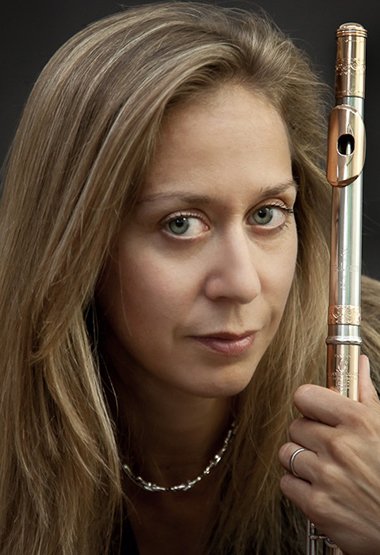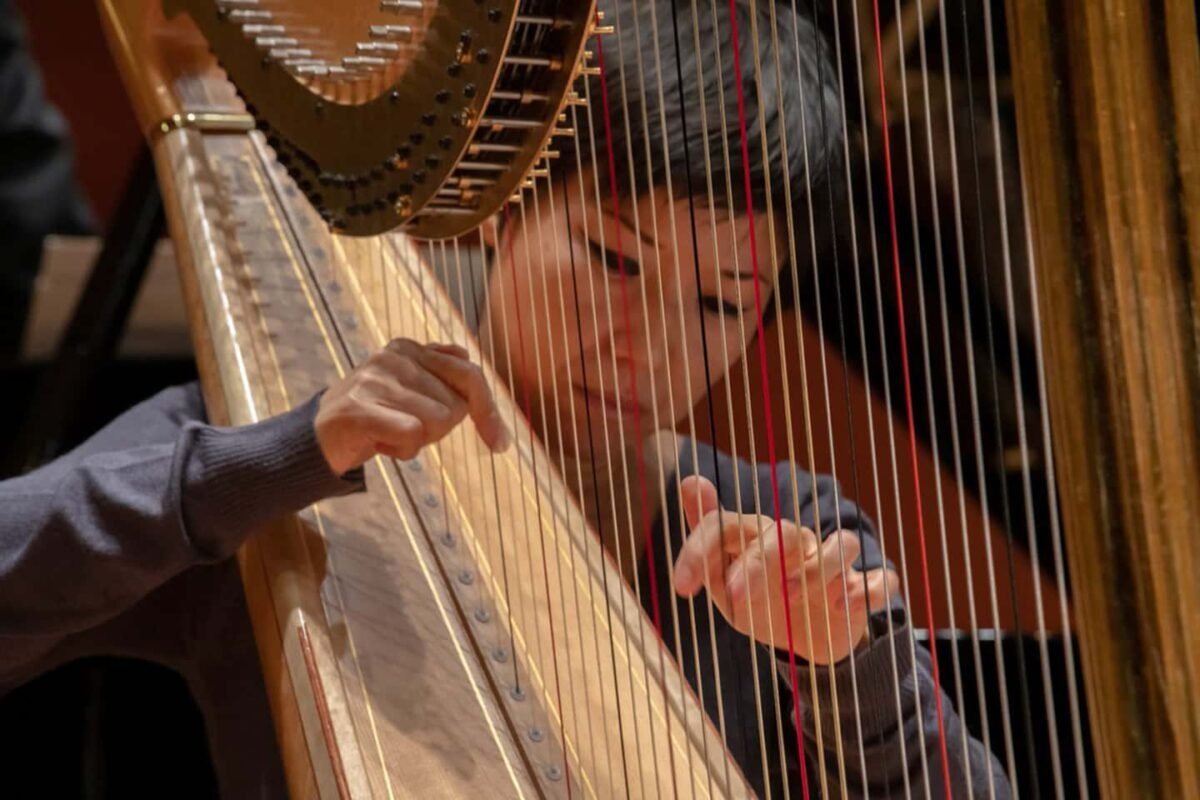‘Piccinini and Friends’ @ Chamber Music Society of Fort Worth
—Gregory Sullivan Isaacs
The Chamber Music Society of Fort Worth has an enviable history of presenting world-class musicians (both international and local) giving definitive performances of chamber music by composers from the Baroque era to the present day. Period.
And though we usually we hear string and piano ensembles from the CMSFW, the concert on September 23, 2023 at the Museum of Modern Art Fort Worth threw a musical curve ball at that assumption, as the Society fielded performances by superstar flutist Marina Piccinini and internationally lauded harpist June Han.
The players were led by violinist Gary Levinson, the senior principal associate concertmaster of the Dallas Symphony Orchestra and artistic director of the CMSFW. The ensemble was completed by DJ Cheek, who joined the Fort Worth Symphony Orchestra as principal viola in Fall 2021, and by cellist Allan Steele, principal cellist of the FWSO.
The music ranged from Mozart through Debussy to the still living Behzad Ranjbaran.
Marina Piccinini is an international flute soloist. Gramophone has called her “the Heifetz of the flute” because of her perfect mastery of technique and exceptional velocity. But that is not really the most outstanding aspect of her playing. Most flutists have such nimble fingers, but with Piccinine it’s the sound she produces that is so striking. The core of her sound is homogeneous in all registers (quite unusual), yet remarkably expressive and flexible for coloring and phrasing.
The program opened with Mozart’s Quartet in D for flute and strings, K.285—a terrific piece from the 21-year old composer, who reportedly disliked the flute. He would have changed his mind if he heard Piccinini play it on a modern flute. The instrument used at the time was the flauto traverso, a wooden instrument lacking in brilliance, with only one key and just six arbitrarily drilled finger holes; thus, it was usually played with squishy intonation.
In spite of the limitations, Mozart wrote a piece that certainly puts the instrument through its paces. Fast tongued and staccato passages contrast with technical fireworks and some very long held notes. Piccinini easily breezed through the work on her modern flute in such a manner that the challenges were nearly unnoticeable.
The first movement is in a concertant style, a forerunner of the concerto. She brought a sprightly energy to its bouncy style. Things were very different in the second, Adagio, movement. Her long clear and spinning passages floated beautifully over a prickly pizzicato accompaniment from the string ensemble (bringing the guitar to mind). The last movement, a rondo, returns to the spritely mood of the first movement. While still leading, Piccinini showed us her collaborative abilities as she became more of a member of the ensemble.
In an almost startling change of musical scenery, Debussy’s gauzy 1917 Sonata for Flute, Viola and Harp followed the Mozart. Debussy described it to his publisher Jacques Durand, as: “…in the old form, so versatile (without the grandiloquence of modern sonatas).”
“Old form” perhaps, but full of forward looking techniques such as blurred meter and modal harmonic colors. And Piccinini’s ability to modify her sound for expressive purposes brought life, vitality and even some melancholy to this multi-mood work. Perhaps the phrase “I laughed, I cried” best fits this performance.
Debussy’s writing in the first movement is based on a series of five musical fragments that appear to float in the ether. Debussy tosses therm around yet giving each three instruments its own “take” on the material. Violist DJ Cheek was superb as he entwined with the sound of the flute while always maintaining a separate identity. Harpist June Han had the hardest job as she varied from accompanist to soloist as the music demanded.
The second movement, a minuet, harkens back to the French Baroque. However, it suddenly brightens to an almost Eastern sound, colored by Cheek’s finely tuned harmonics on the viola.
The final movement sheds its gauzy politeness for a exciting conclusion. Harpist Han propelled the music forward with chords in a quick and repeated pattern. Cheek demonstrated his ability to perform some special effects such as scratchy ponticello (bow close the bridge) and Bartok-like snap pizzicati. Piccinini flashed up and down the instrument leaving a trail of fire. But most importantly in this movement, the performers were excellent in observing the critical dynamics and the capricious, sometimes short-lived, tempi markings. It is a sonic roller coaster ride. Debussy shuffles motives, using exaggerated crescendo and diminuendo markings, flashing grace notes, diabolical trills, sudden accelerandi. The three performers brought the piece back to earth but got some intended laughter with Debussy’s tease of an ending.
Ending the first half, we entered a crazed musical world with Behzad Ranjbaran’s Fountains of Fin. These fountains, located in Kasha (Iran), date from the 16th century, and while quite beautiful, they carry a grisly reputation. In 1852, King Nasereddin Shah, had Qajarid chancellor Amir Kabin assassinated there. The work is cast in three but continuous movements.
Piccinini opened this evocative but appropriately disturbing, piece with some ruminative solo cadenzi displaying the very rich sound of her instrument’s lower register. The string interjections from Levinson and Steele, all dissonant intervals, climb up and down like complaints. Often, the flute and strings stand apart—teasing, commenting, even hurling accusations.
As to the playing, the instrumentalists tried to gain control of Ranjbaran’s bi-polar music. It jumps from truncated fugal start-ups, mini-ostinati, interloping pizzicati passages, exhausted quarter-tone flute sighs, lots of imitation, rare convergences, an orgy of on-purpose dissonances, and even the occasional appearance of a lovely stray chord. The bemused audience gave it an appreciative ovation—maybe an “A” for effort.
The afternoon’s second half opened with an amuse-bouche by the legendary violin firebrand, Niccolò Paganini, his Serenade for Flute, Violin and Harp. Originally it was scored for two violins and guitar, but here one violin part goes to the flute and the guitar part is assumed by the harp. (The inventive arranger is unknown.) In such a heavy program, this delightful piece of virtuosic fluff hit the spot. Everyone, players and audience alike, had fun.
The next musical world we visited was with Hector Villa-Lobos. Assobio a Jato (The Jet Whistle), for flute and cello, is reminiscent of the street bands sometimes heard in the capitals of Brazil. The work gets its name from a special effect assigned to Piccinini in the last movement, after a series of ever-ascending scales give the effect of the instrument running out of notes. At this point, Villa-Lobos asked for pitchless and forceful overblowing of the flute, intending this to sound like jet taking off. Piccinini made it sound as if she was frustrated that a piccolo wasn’t handy—to let her continue with the series of scales. We loved it.
Villa-Lobos’ first movement, marked Allegro non troppo, presents a quasi-improvised pseudo-folk song, with Steele and Piccinini aggressively trading places as soloist and accompanist. The slow movement allowed us to hear the pair in a more serious moment. Here, Piccinini lavished her rich sound on a wandering tune, accompanied by Steele’s perfectly tuned double stops. The finale let both artists display virtuosity, alternating with more lyric passages.
The program ended with another change of musical venue. Chant de Linos (for flute and piano) was written by French composer/flutist André Jolivet in 1944. Soon after, he made this transcription for harp and string trio. Both versions are extremely difficult for everyone, but especially for the flutist. (A flutist in the audience commented that the flute part is transcendently difficult, but it didn’t sound that way in Piccinini’s hands.)
The title refers to Linus, a mournful mythological musician who instructed both Orpheus and Heracles. Thus, Jolivet employs ancient Greek myth and lamentation, grouped into irregular phrases, and sets it in an unusual (maybe invented?) model scale. Piccinini certainly rose to the composer’s virtuosic summons with jaw-dropping acrobatics, sudden dynamic explosions and flutter-tonguing.
Chant de Linos opens with flute flights of fancy and forceful harp commentary, sometimes sounding like a woodblock. Widely spaced, accented and dissonant groans emerge from the firm of Levinson, Cheek, and Steele. Piccinini defused the action and brought the movement down to a melancholy final cadenza.
The second section (moderate in 3/4) presented the entire ensemble playing a tapestry of wandering musical lines over some proffered harp chords and interjections. Piccinini’s sound was mesmerizing. The composer woke us all up with a sudden musical eruption whose energy was short-lived.
The next section (fast in 7/8) was marked by Piccinini negotiating some wild acrobatics ending in a thoughtful cadenza. The finale (moderate in 7/8) uses fast repeated notes, characteristic of the instrument, combined with flashy upward scales that propel the music ever forward. The trio, with virtuosity demands of its own, and with Han’s aggressive glissando on the harp, added their own interjections. The passage seemed to fade with a languid flute deceleration and a following slow section allowing us to hear Han’s gorgeously rolled harp chords. The work ended with a return to the feeling of the movement’s opening, but offered even more of a scramble, leading to a final fffz stinger. WooHoo!
WHEN: Museum of Modern Art Fort Worth, 3200 Darnell Street, Fort Worth TX
WHERE: Next CMSFW concert October 7, 2023—The Dover Quartet
WEB: cmsfw.org

